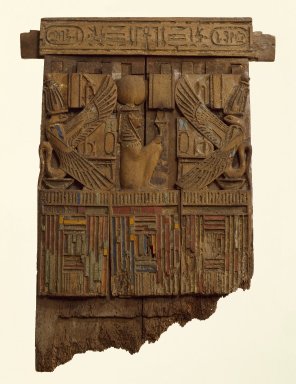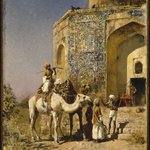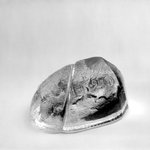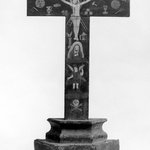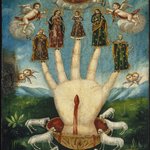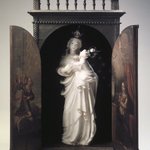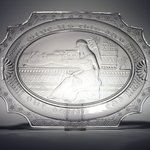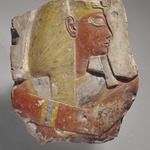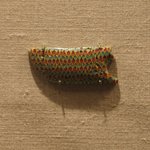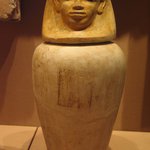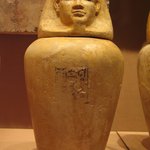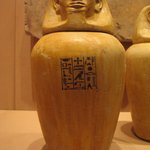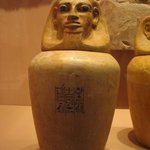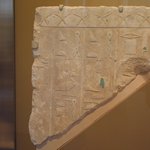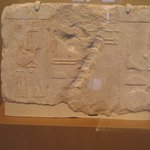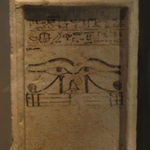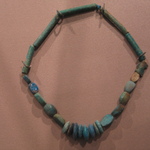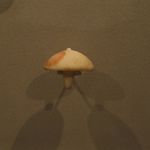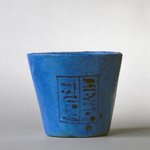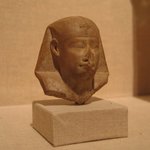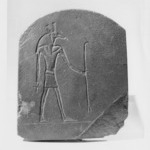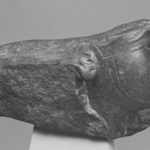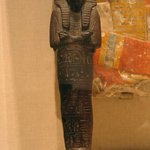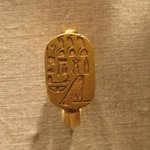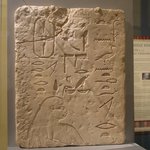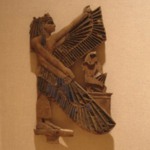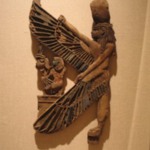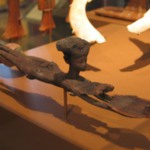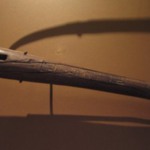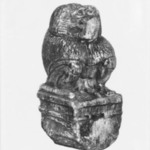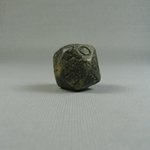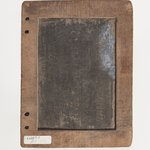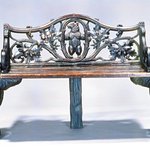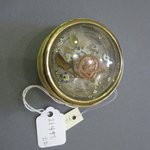

Central Panel from a Shrine for a Divine Image, ca. 664–342 B.C.E. Wood, glass, 18 1/2 x 13 3/8 x 1 3/8 in. (47 x 34 x 3.5 cm). Brooklyn Museum, Charles Edwin Wilbour Fund, 37.258E. Creative Commons-BY (Photo: Brooklyn Museum, CUR.37.258E_overall.jpg)
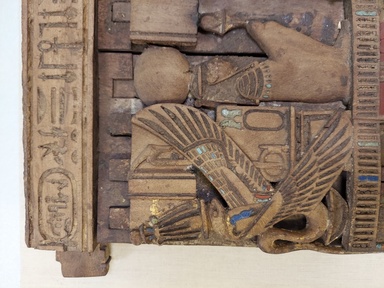
Central Panel from a Shrine for a Divine Image, ca. 664–342 B.C.E. Wood, glass, 18 1/2 x 13 3/8 x 1 3/8 in. (47 x 34 x 3.5 cm). Brooklyn Museum, Charles Edwin Wilbour Fund, 37.258E. Creative Commons-BY (Photo: Brooklyn Museum, CUR.37.258E_detail01.jpg)
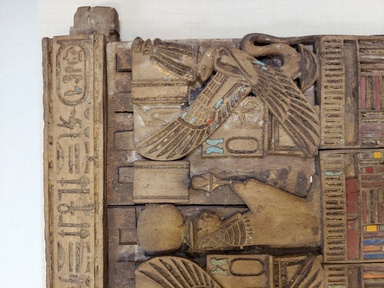
Central Panel from a Shrine for a Divine Image, ca. 664–342 B.C.E. Wood, glass, 18 1/2 x 13 3/8 x 1 3/8 in. (47 x 34 x 3.5 cm). Brooklyn Museum, Charles Edwin Wilbour Fund, 37.258E. Creative Commons-BY (Photo: Brooklyn Museum, CUR.37.258E_detail02.jpg)

Central Panel from a Shrine for a Divine Image, ca. 664–342 B.C.E. Wood, glass, 18 1/2 x 13 3/8 x 1 3/8 in. (47 x 34 x 3.5 cm). Brooklyn Museum, Charles Edwin Wilbour Fund, 37.258E. Creative Commons-BY (Photo: Brooklyn Museum, CUR.37.258E_detail03.jpg)
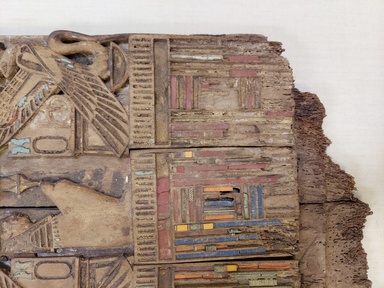
Central Panel from a Shrine for a Divine Image, ca. 664–342 B.C.E. Wood, glass, 18 1/2 x 13 3/8 x 1 3/8 in. (47 x 34 x 3.5 cm). Brooklyn Museum, Charles Edwin Wilbour Fund, 37.258E. Creative Commons-BY (Photo: Brooklyn Museum, CUR.37.258E_detail04.jpg)

Central Panel from a Shrine for a Divine Image, ca. 664–342 B.C.E. Wood, glass, 18 1/2 x 13 3/8 x 1 3/8 in. (47 x 34 x 3.5 cm). Brooklyn Museum, Charles Edwin Wilbour Fund, 37.258E. Creative Commons-BY (Photo: Brooklyn Museum, CUR.37.258E_detail05.jpg)

Central Panel from a Shrine for a Divine Image, ca. 664–342 B.C.E. Wood, glass, 18 1/2 x 13 3/8 x 1 3/8 in. (47 x 34 x 3.5 cm). Brooklyn Museum, Charles Edwin Wilbour Fund, 37.258E. Creative Commons-BY (Photo: Brooklyn Museum, CUR.37.258E_detail06.jpg)
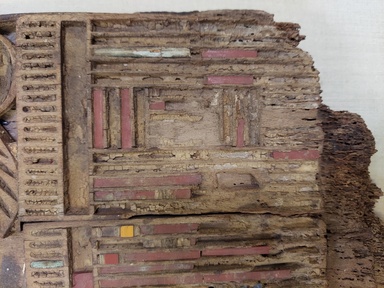
Central Panel from a Shrine for a Divine Image, ca. 664–342 B.C.E. Wood, glass, 18 1/2 x 13 3/8 x 1 3/8 in. (47 x 34 x 3.5 cm). Brooklyn Museum, Charles Edwin Wilbour Fund, 37.258E. Creative Commons-BY (Photo: Brooklyn Museum, CUR.37.258E_detail07.jpg)
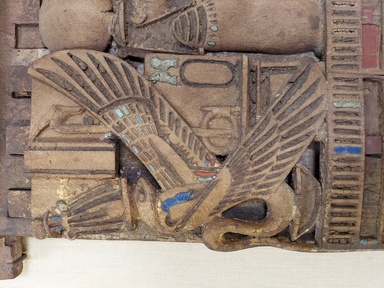
Central Panel from a Shrine for a Divine Image, ca. 664–342 B.C.E. Wood, glass, 18 1/2 x 13 3/8 x 1 3/8 in. (47 x 34 x 3.5 cm). Brooklyn Museum, Charles Edwin Wilbour Fund, 37.258E. Creative Commons-BY (Photo: Brooklyn Museum, CUR.37.258E_detail08.jpg)
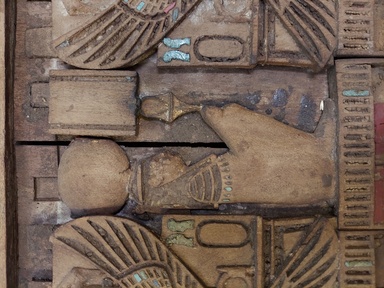
Central Panel from a Shrine for a Divine Image, ca. 664–342 B.C.E. Wood, glass, 18 1/2 x 13 3/8 x 1 3/8 in. (47 x 34 x 3.5 cm). Brooklyn Museum, Charles Edwin Wilbour Fund, 37.258E. Creative Commons-BY (Photo: Brooklyn Museum, CUR.37.258E_detail09.jpg)

Central Panel from a Shrine for a Divine Image, ca. 664–342 B.C.E. Wood, glass, 18 1/2 x 13 3/8 x 1 3/8 in. (47 x 34 x 3.5 cm). Brooklyn Museum, Charles Edwin Wilbour Fund, 37.258E. Creative Commons-BY (Photo: Brooklyn Museum, CUR.37.258E_detail10.jpg)
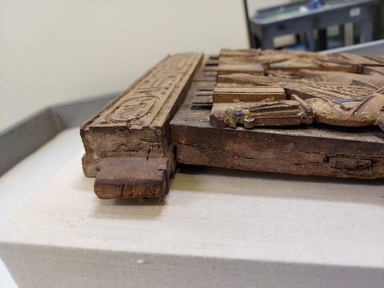
Central Panel from a Shrine for a Divine Image, ca. 664–342 B.C.E. Wood, glass, 18 1/2 x 13 3/8 x 1 3/8 in. (47 x 34 x 3.5 cm). Brooklyn Museum, Charles Edwin Wilbour Fund, 37.258E. Creative Commons-BY (Photo: Brooklyn Museum, CUR.37.258E_detail11.jpg)
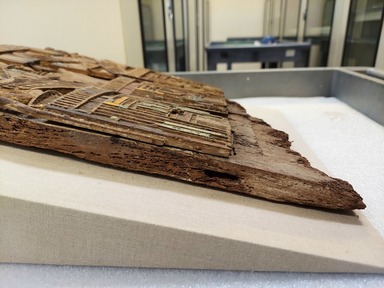
Central Panel from a Shrine for a Divine Image, ca. 664–342 B.C.E. Wood, glass, 18 1/2 x 13 3/8 x 1 3/8 in. (47 x 34 x 3.5 cm). Brooklyn Museum, Charles Edwin Wilbour Fund, 37.258E. Creative Commons-BY (Photo: Brooklyn Museum, CUR.37.258E_detail12.jpg)

Central Panel from a Shrine for a Divine Image, ca. 664–342 B.C.E. Wood, glass, 18 1/2 x 13 3/8 x 1 3/8 in. (47 x 34 x 3.5 cm). Brooklyn Museum, Charles Edwin Wilbour Fund, 37.258E. Creative Commons-BY (Photo: Brooklyn Museum, CUR.37.258E_detail13.jpg)
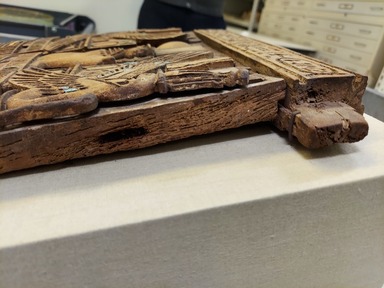
Central Panel from a Shrine for a Divine Image, ca. 664–342 B.C.E. Wood, glass, 18 1/2 x 13 3/8 x 1 3/8 in. (47 x 34 x 3.5 cm). Brooklyn Museum, Charles Edwin Wilbour Fund, 37.258E. Creative Commons-BY (Photo: Brooklyn Museum, CUR.37.258E_detail14.jpg)

Central Panel from a Shrine for a Divine Image, ca. 664–342 B.C.E. Wood, glass, 18 1/2 x 13 3/8 x 1 3/8 in. (47 x 34 x 3.5 cm). Brooklyn Museum, Charles Edwin Wilbour Fund, 37.258E. Creative Commons-BY (Photo: Brooklyn Museum, CUR.37.258E_detail15.jpg)
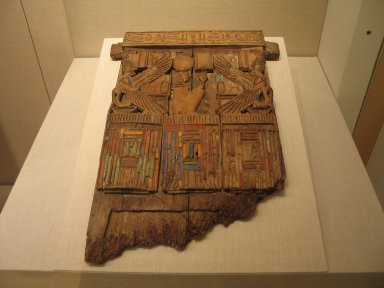
Central Panel from a Shrine for a Divine Image, ca. 664–342 B.C.E. Wood, glass, 18 1/2 x 13 3/8 x 1 3/8 in. (47 x 34 x 3.5 cm). Brooklyn Museum, Charles Edwin Wilbour Fund, 37.258E. Creative Commons-BY (Photo: Brooklyn Museum, CUR.37.258E_wwg8.jpg)
Central Panel from a Shrine for a Divine Image
Egyptian, Classical, Ancient Near Eastern Art
On View: 19th Dynasty to Roman Period, Martha A. and Robert S. Rubin Gallery, 3rd Floor
The central panel here is inscribed for the Thirtieth Dynasty king Nectanebo II (reigned circa 360–342 B.C.). It comes from a shrine that presumably held a cult statue of the squatting goddess it depicts. Showing a figure in heavy, enveloping robes like this was a standard way of representing deities and symbolizing protection and the potential for life and regeneration. The resemblance to a wrapped mummy has led some Egyptologists to wonder: Is a mummy a body stylized into a divine image?
The side panels are probably from a different and earlier shrine.


